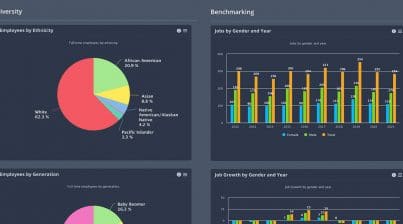Many of us have had the unfortunate experience of there being someone at work with whom you’ve conflicted. It may have been a simple misunderstanding, a different idea of how a project should be tackled, or even something deeper. You may have felt your boss didn’t handle a situation well but many of us keep our heads down because we have learned that workplace conflict can impact us negatively.
Just as the Thanksgiving table can be fraught with conflict as your Uncle Ed’s opinions on politics are a little unpopular, your Grandfather only talks about “the war” and how we’ve never had it so good, and your mother spends time (not unfoundedly) wrangling everyone to help with clean-up when they want to relax, being part of group dynamics is never easy.
And that’s especially true at work, particularly when you have a diverse group of people with different lived experiences, opinions, goals, and expectations. In the workplace, managers and C-suite executives have different agendas and ideas of what needs to be done. Those in management may differ in ideas from those in the team actually doing the work. There’s drama (even if internal), there’s mistrust, and there’s unease.
Workplace conflict costs a whopping $359 billion per year which is exactly why every HR management team needs a strategy to handle it. Here’s why HR leaders struggle with confrontation and how to use it for good.
What is workplace conflict?
Workplace conflict, or organizational conflict, is where there’s a “state of discord caused by the actual or perceived opposition of needs, values and interests between people working together.” So, when people work together, what they want and need (or what they think they want and need) often seems to conflict with what others want or need in the organization.
If you’ve ever worked in a hyper-productive department where requests and work are handled quickly and you come across a department that takes eight days to answer your email and another fifteen days to do anything about it, you may have experienced some slight organizational discord.
Some argue that there are five forms of workplace conflict: leadership conflict, interdependency-based conflict, workstyle differences, cultural-based dissent, and personality clashes.
In leadership conflict, there’s a disconnect for employees between all the leadership styles they face. They may have to deal with team managers, line managers, “Head ofs,” and CEOs in the same day. Everyone’s leadership style differs and some leaders are open, transparent, and trusting, whilst others are authoritative and autocratic. Some leaders feel they’ve hired the best people for the role and they better get out of the way and let that person do their job – and have autonomy doing it. And others feel that they want to micromanage every task. Depending on the leadership styles that each employee wants, that can lead to conflict.
With interdependency-based conflict, it goes back to the example of a hyper-productive team working with a slow one. If your work depends on the output of others and that other team is always late with the sales figures or the report or the presentation (or whatever), the ground is ripe for conflict.
The above can also exacerbate workstyle differences. Some employees want to work efficiently alone and put their head down whilst others love working collaboratively and like to have lots of managerial input. How teams and individuals are managed can cause conflict with different working styles if it doesn’t suit the person you’re working with.
Cultural differences in the workplace also need to be accounted for and all in the organization need to be sensitive to differences. DEI initiatives work and companies perform better with diverse workforces, but diverse staff can feel overwhelmed if their needs aren’t taken into account – with the whole inclusion part of DEI.
Then there are good old personality clashes. No matter how hard people try, not everyone will get along. Those perceived differences, values, motivations, etc may be entirely unfounded but people form snapshots of others (rightly or wrongly) and those perceptions can cause conflict. If a team leader insults a member of the team there may be conflict and resentment down the line that will need to be addressed, as an example.
With HR professionals, it may be difficult to step in to manage conflict because you don’t fully understand the dynamics within a team or department. You may simply not know where to begin.
How can HR management reduce organizational confrontation?
Nate Regier, a former psychologist and author of Conflict Without Casualties, notes that “Conflict is simply the energy created by the gap between what we want and what we’re experiencing. …If we define conflict as energy that’s created by the gap, then the real question is ‘How are we going to use that energy?’”
Another way to look at conflict is that just because your employees aren’t speaking up doesn’t mean they’re happy. It may get some employees in trouble (unfortunately) but when employees speak up about what they’re unhappy with or how they want things to improve and what they want to change, then it means they’re invested in the company.
Good HR managers and leaders understand that conflict isn’t always destructive and can be leveraged in the right way. So instead of seeing it as something that needs management and control, it can be understood and handled with compassion.
Leveraging conflict means HR managers should understand the motives, emotions, and responses of employees – are they reacting because of poorly handled change management, as an example? Listen to your employees and understand why they’re upset/feeling as they are and try and find solutions together. Validate how they feel.
HR should encourage all employees to share thoughts and ideas and disagree by respecting others’ intentions. And expectations need to be clear and each employee needs to be accountable.
Employees need to feel in control, to some degree, of their work environment and their tasks, which is where employee engagement and autonomy come in.
Related: Tips for de-escalating workplace conflicts
How can Employee Cycle help you with workplace confrontation?
Employee cycle can help you monitor performance, engagement, and turnover. If your employees have low performance, low engagement, and high turnover – company-wide or especially in a department – then there may be conflict that needs leveraging. Employee Cycle can help you track your metrics.
Many of us have had the unfortunate experience of there being someone at work with whom you’ve conflicted. It may have been a simple misunderstanding, a different idea of how a project should be tackled, or even something deeper. You may have felt your boss didn’t handle a situation well but many of us keep our heads down because we have learned that workplace conflict can impact us negatively.
Just as the Thanksgiving table can be fraught with conflict as your Uncle Ed’s opinions on politics are a little unpopular, your Grandfather only talks about “the war” and how we’ve never had it so good, and your mother spends time (not unfoundedly) wrangling everyone to help with clean-up when they want to relax, being part of group dynamics is never easy.
And that’s especially true at work, particularly when you have a diverse group of people with different lived experiences, opinions, goals, and expectations. In the workplace, managers and C-suite executives have different agendas and ideas of what needs to be done. Those in management may differ in ideas from those in the team actually doing the work. There’s drama (even if internal), there’s mistrust, and there’s unease.
Workplace conflict costs a whopping $359 billion per year which is exactly why every HR management team needs a strategy to handle it. Here’s why HR leaders struggle with confrontation and how to use it for good.
What is workplace conflict?
Workplace conflict, or organizational conflict, is where there’s a “state of discord caused by the actual or perceived opposition of needs, values and interests between people working together.” So, when people work together, what they want and need (or what they think they want and need) often seems to conflict with what others want or need in the organization.
If you’ve ever worked in a hyper-productive department where requests and work are handled quickly and you come across a department that takes eight days to answer your email and another fifteen days to do anything about it, you may have experienced some slight organizational discord.
Some argue that there are five forms of workplace conflict: leadership conflict, interdependency-based conflict, workstyle differences, cultural-based dissent, and personality clashes.
In leadership conflict, there’s a disconnect for employees between all the leadership styles they face. They may have to deal with team managers, line managers, “Head ofs,” and CEOs in the same day. Everyone’s leadership style differs and some leaders are open, transparent, and trusting, whilst others are authoritative and autocratic. Some leaders feel they’ve hired the best people for the role and they better get out of the way and let that person do their job – and have autonomy doing it. And others feel that they want to micromanage every task. Depending on the leadership styles that each employee wants, that can lead to conflict.
With interdependency-based conflict, it goes back to the example of a hyper-productive team working with a slow one. If your work depends on the output of others and that other team is always late with the sales figures or the report or the presentation (or whatever), the ground is ripe for conflict.
The above can also exacerbate workstyle differences. Some employees want to work efficiently alone and put their head down whilst others love working collaboratively and like to have lots of managerial input. How teams and individuals are managed can cause conflict with different working styles if it doesn’t suit the person you’re working with.
Cultural differences in the workplace also need to be accounted for and all in the organization need to be sensitive to differences. DEI initiatives work and companies perform better with diverse workforces, but diverse staff can feel overwhelmed if their needs aren’t taken into account – with the whole inclusion part of DEI.
Then there are good old personality clashes. No matter how hard people try, not everyone will get along. Those perceived differences, values, motivations, etc may be entirely unfounded but people form snapshots of others (rightly or wrongly) and those perceptions can cause conflict. If a team leader insults a member of the team there may be conflict and resentment down the line that will need to be addressed, as an example.
With HR professionals, it may be difficult to step in to manage conflict because you don’t fully understand the dynamics within a team or department. You may simply not know where to begin.
How can HR management reduce organizational confrontation?
Nate Regier, a former psychologist and author of Conflict Without Casualties, notes that “Conflict is simply the energy created by the gap between what we want and what we’re experiencing. …If we define conflict as energy that’s created by the gap, then the real question is ‘How are we going to use that energy?’”
Another way to look at conflict is that just because your employees aren’t speaking up doesn’t mean they’re happy. It may get some employees in trouble (unfortunately) but when employees speak up about what they’re unhappy with or how they want things to improve and what they want to change, then it means they’re invested in the company.
Good HR managers and leaders understand that conflict isn’t always destructive and can be leveraged in the right way. So instead of seeing it as something that needs management and control, it can be understood and handled with compassion.
Leveraging conflict means HR managers should understand the motives, emotions, and responses of employees – are they reacting because of poorly handled change management, as an example? Listen to your employees and understand why they’re upset/feeling as they are and try and find solutions together. Validate how they feel.
HR should encourage all employees to share thoughts and ideas and disagree by respecting others’ intentions. And expectations need to be clear and each employee needs to be accountable.
Employees need to feel in control, to some degree, of their work environment and their tasks, which is where employee engagement and autonomy come in.
How can Employee Cycle help you with workplace confrontation?
Employee cycle can help you monitor performance, engagement, and turnover. If your employees have low performance, low engagement, and high turnover – company-wide or especially in a department – then there may be conflict that needs leveraging. Employee Cycle can help you track your metrics. Schedule your free demo today to find out more.












